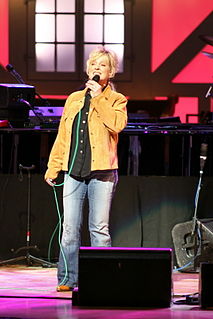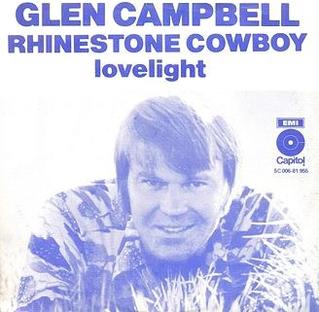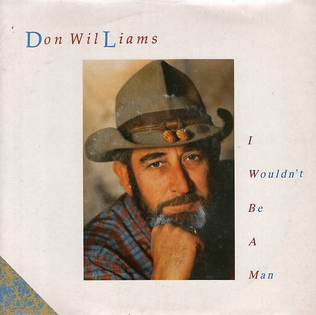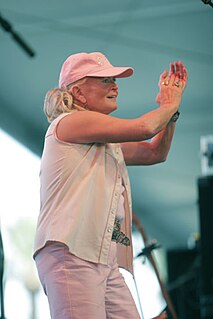Related Research Articles

Glen Travis Campbell was an American guitarist, singer, songwriter, actor and television host. He was best known for a series of hit songs in the 1960s and 1970s, and for hosting The Glen Campbell Goodtime Hour on CBS television from 1969 until 1972. He released 64 albums in a career that spanned five decades, selling over 45 million records worldwide, including twelve gold albums, four platinum albums, and one double-platinum album.

Brooks & Dunn is an American country music duo consisting of Kix Brooks and Ronnie Dunn, both of whom are vocalists and songwriters. The duo was founded in 1990 through the suggestion of Tim DuBois. Before the foundation, both members were solo recording artists. Both members charted two solo singles apiece in the 1980s, with Brooks also releasing an album for Capitol Records in 1989 and writing hit singles for other artists.

Connie Smith is an American country music singer and songwriter. Her contralto vocals have been described by music writers as significant and influential to the women of country music. A similarity has been noted between her vocal style and the stylings of country vocalist Patsy Cline. Other performers have cited Smith as influence on their own singing styles, which has been reflected in quotes and interviews over the years.

"Kentucky Rain" is a 1970 song written by Eddie Rabbitt and Dick Heard and recorded by Elvis Presley. It was recorded at American Sound Studio and features then session pianist Ronnie Milsap. Other musicians on the record include Bobby Wood on piano, Bobby Emmons on organ, Reggie Young on guitar, Tommy Cogbill on bass and Gene Chrisman on drums. The song and session was produced by Felton Jarvis (RCA-Victor) and Chips Moman. It was certified Gold by the RIAA, signifying United States sales of more than a million copies.

Robert Charles Goldsboro is an American pop and country singer-songwriter. He had a string of pop and country hits in the 1960s and 1970s, including his signature No. 1 hit "Honey", which sold over 1 million copies in the United States, and the UK top-10 single "Summer ".
Charles Kindred Vassy was a singer-songwriter, who in addition to his solo recordings also recorded with other artists, most notably Kenny Rogers, Frank Zappa and Elvis Presley.

"Rhinestone Cowboy" is a song written by Larry Weiss and most famously recorded by American country music singer Glen Campbell. When released in 1975, it enjoyed huge popularity with both country and pop audiences.
Bobby Russell was an American singer and songwriter. Between 1966 and 1973, he had five singles on the Hot Country Songs charts, including the crossover pop hit "Saturday Morning Confusion". Russell was married to singer and actress Vicki Lawrence from 1972 to 1974.
"By the Time I Get to Phoenix" is a song written by Jimmy Webb. Originally recorded by Johnny Rivers in 1965, it was covered by American country music singer Glen Campbell on his album of the same name. Released on Capitol Records in 1967, Campbell's version topped RPM's Canada Country Tracks, reached number two on Billboard's Hot Country Singles chart, and won two awards at the 10th Annual Grammys. Broadcast Music, Inc. (BMI) named it the third most performed song from 1940 to 1990. The song was ranked number 20 on BMI's Top 100 Songs of the Century. Frank Sinatra called it "the greatest torch song ever written."
"Sing a Sad Song" is a song written by Wynn Stewart. It was recorded notably by Merle Haggard in 1963, whose version became his first major hit. It was later recorded by Stewart himself. In 1976, Stewart's own version became a major hit as well.

The American singer Emmylou Harris has released 26 studio albums, four live albums, 11 compilation albums, three video albums, and 70 singles. After releasing a debut folk album on the Jubilee label in 1969 and recording with Gram Parsons, Harris signed with Reprise Records in 1974.

"I Just Want to Be Your Everything" is a song recorded by Andy Gibb, initially released in April 1977 as the first single from his debut album Flowing Rivers. It reached number 1 on the Billboard Hot 100 for three weeks, starting on the week ending 30 July 1977, and again for the week ending 17 September 1977. It was Gibb's first single released in the United Kingdom and United States. His previous single, "Words and Music" was only released in Australia. It is ranked number 26 on Billboard's 55th anniversary All Time Top 100 list.
The discography of Buck Owens, an American country music artist, consists of 39 studio albums, 16 compilation albums, 9 live albums, 97 singles, and 12 B-sides. After recording under the name Corky Jones and releasing a string of singles in the mid-1950s, Owens signed a recording contract with Capitol Records in February 1957.
"A Satisfied Mind" is a song written by Joe "Red" Hayes and Jack Rhodes. Hayes explained the origin of the song in an interview: "The song came from my mother. Everything in the song are things I heard her say over the years. I put a lot of thought into the song before I came up with the title. One day my father-in-law asked me who I thought the richest man in the world was, and I mentioned some names. He said, 'You're wrong; it is the man with a satisfied mind.'"
"Lovin' Her Was Easier " is a song written, composed, first recorded, and first released by Kris Kristofferson. It was also recorded and released by Roger Miller, who included it on his album The Best of Roger Miller and released it as a single in July 1971. Ten years later, it was recorded by Tompall & the Glaser Brothers for the album Lovin' Her Was Easier.

"I Wouldn't Be a Man" is a song written by Mike Reid and Rory Bourke. Originally recorded by Don Williams, it has also been covered by Billy Dean and Josh Turner. Williams's version of the song was a Top Ten country hit in late 1987–early 1988, while versions by Dean and Turner also charted.
"What a Way to Go" is a song written by Bobby David and Jim Rushing. It was originally recorded by Bobby Borchers in 1977 on Playboy Records.

American country artist Loretta Lynn has released 86 singles, two B-sides and 14 music videos. Her debut single was "I'm a Honky Tonk Girl" (1960) via Zero Records. Promoting the song with her husband by driving to each radio station, the effort paid off when it peaked at number fourteen on the Billboard Hot Country Songs chart. Arriving in Nashville, Tennessee, that year, she signed a recording contract with Decca Records. In 1962, "Success" reached the sixth position on the country songs chart, starting a series of top ten hits including "Wine Women and Song" and "Blue Kentucky Girl". She began collaborating with Ernest Tubb in 1964 and recorded four hit singles with him, including "Mr. and Mrs. Used to Be". Lynn's popularity greatly increased in 1966 when she began releasing her own compositions as singles. Among the first was "You Ain't Woman Enough " which reached the second position on the country songs list. She then reached the number one spot with "Don't Come Home A-Drinkin' " (1967). This was followed by "Fist City" (1968) and "Woman of the World " (1969).

The singles discography of American country music artist Lynn Anderson contains 72 singles, three promotional singles, one charting B-side, two music videos and nine other song appearances. She signed her first recording contract with Chart Records in 1966. The following year, her single "Ride, Ride, Ride" debuted on the Billboard Hot Country Singles chart. Also in 1967, her single "If I Kiss You " became her first major hit when it reached number five on the country singles chart. Anderson had a series of hits that reached the top ten and 20 during the 1960s including "Promises, Promises" (1969), "No Another Time" (1968), "Big Girls Don't Cry" (1968) and "That's a No No" (1969).

The discography of American country singer-songwriter Hank Locklin contains 29 studio albums, 10 compilation albums, two box sets, 96 singles, two additionally-charting songs and one album appearance. He had his first hit with "The Same Sweet Girl" (1949) after signing with Four Star Records. The song reached the top ten of the Billboard country singles chart, peaking at number eight. A string of singles were released over the next several years that were not successful. With a leasing agreement administered by Decca Records, he had his next hit in 1953 with the number one song, "Let Me Be the One." Disappointed by label management, he switched to RCA Victor Records in 1955. Under the production of Chet Atkins, he had his biggest success. His next hit came with 1956's "Why Baby Why," which reached number nine on the country chart. Between 1957 and 1958, he had three top ten country hits: "Send Me the Pillow You Dream On," "Geisha Girl" and "It's a Little More Like Heaven." In 1958, he recorded among country music's first concept albums called Foreign Love. In 1960, Locklin released his biggest hit single, "Please Help Me, I'm Falling." Not only did it top the Billboard country singles chart, but it also reached number eight on the Billboard Hot 100 list. It was also one of several hits Locklin had in the United Kingdom, peaking at number nine on their pop chart.
References
- ↑ King, Robert (June 5, 1979). "Bobby Borchers, Full Circle to Perform". The Dispatch. Retrieved September 13, 2010.
- 1 2 3 4 Whitburn, Joel (2008). Hot Country Songs 1944 to 2008. Record Research, Inc. p. 56. ISBN 978-0-89820-177-2.
- ↑ "Night Life: Northern Kentucky". Cincinnati Magazine: A20. June 1982.
- ↑ "Chart history for Bobby Borchers". Allmusic . Retrieved September 13, 2010.
- ↑ "Chart history for Denim and Rhinestones". Allmusic. Retrieved September 13, 2010.
- ↑ "Search results for Bobby Borchers". RPM . Archived from the original on October 18, 2012. Retrieved September 13, 2010.